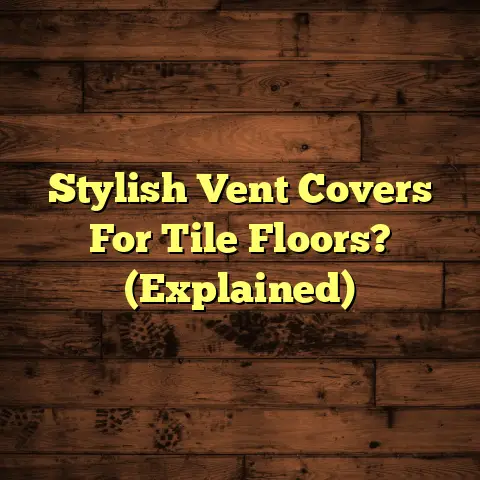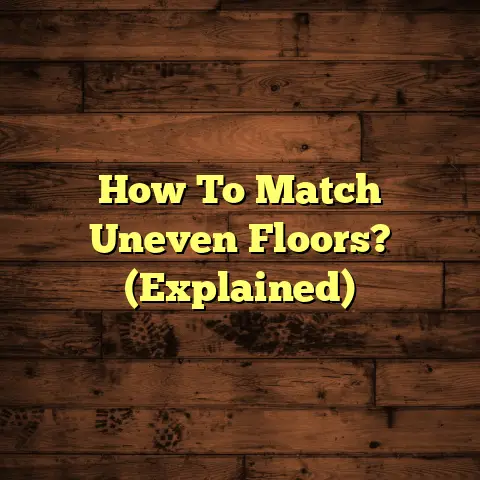Is Vinyl Wood Right? (3 Must-Know Facts!)
(3 Must-Know Facts!)
Ever walked into a room and thought, “Wow, that floor looks amazing!”?Chances are, you were admiring vinyl wood flooring. It’s everywhere these days, and for good reason.
As a flooring contractor with years under my belt, I’ve seen trends come and go. But vinyl wood? This stuff has staying power.
Why? Because it’s not just pretty. It’s practical, budget-friendly, and even eco-conscious in some cases.
But is it right for your home? That’s what we’re going to explore. I’m going to break down the three must-know facts about vinyl wood flooring.
Think of it as a friendly chat over coffee, where I spill the beans on everything you need to know. Let’s dive in!
Understanding Vinyl Wood Flooring
Okay, first things first: what exactly is vinyl wood flooring?
It’s not real wood, that’s for sure. Instead, it’s a synthetic material designed to mimic the look of hardwood.
Think of it as the chameleon of the flooring world. It can convincingly imitate oak, maple, walnut, you name it!
What’s it Made Of?
Vinyl wood flooring is typically made of several layers:
-
Backing Layer: This is the foundation, providing stability and cushioning.
-
Core Layer: This layer is usually made of PVC (polyvinyl chloride) or a composite material, making the floor waterproof.
-
Print Layer: This is where the magic happens! A high-resolution image of real wood is printed onto this layer, creating the realistic wood look.
-
Wear Layer: This is the top layer, a transparent coating that protects the print layer from scratches, stains, and wear.
Types of Vinyl Wood Flooring
Now, there’s more than one type of vinyl wood out there. Here’s a quick rundown:
-
Luxury Vinyl Planks (LVP): These are individual planks that look and feel very similar to real wood. They’re thicker and more durable than other types of vinyl.
-
Luxury Vinyl Tile (LVT): Similar to LVP, but in tile form. Great for creating patterns and designs.
-
Vinyl Sheets: These come in large rolls and are typically used in bathrooms and kitchens. They’re waterproof and easy to install.
The Visual Appeal
Let’s be honest, the biggest draw of vinyl wood is its appearance.
Advancements in printing technology have made it incredibly realistic.
You can find vinyl planks with embossed textures that mimic the grain of real wood.
Some even have beveled edges to further enhance the authentic look.
I’ve had clients who were shocked to learn that their “wood” floor was actually vinyl!
Must-Know Fact #1:
Durability and Maintenance
Alright, let’s get to the first must-know fact: durability and maintenance. This is where vinyl wood really shines.
Durability: A Warrior Against Wear and Tear
One of the biggest advantages of vinyl wood is its resistance to scratches, dents, and moisture.
Unlike real wood, it won’t easily scratch from pet claws or furniture legs. It’s also waterproof, making it perfect for kitchens, bathrooms, and even basements.
I’ve seen firsthand how well vinyl wood holds up in high-traffic areas. Families with kids and pets love it because it can handle the daily wear and tear without showing its age.
Expert Opinions & Statistics:
According to a report by MarketWatch, the global luxury vinyl flooring market is expected to grow significantly in the coming years, driven by its durability and water-resistance.
This isn’t just marketing hype; it’s based on real-world performance.
Maintenance: A Breeze to Keep Clean
Forget about sanding, refinishing, and special wood cleaners. Vinyl wood is incredibly easy to maintain.
A simple sweep or vacuum is usually enough to keep it clean. For spills and messes, a damp mop with a mild detergent will do the trick.
I always tell my clients to avoid using harsh chemicals or abrasive cleaners, as these can damage the wear layer.
Tips for Keeping Vinyl Flooring Looking Its Best
-
Use doormats: Place mats at entrances to trap dirt and debris.
-
Protect furniture legs: Use felt pads under furniture legs to prevent scratches.
-
Clean spills immediately: Wipe up spills as soon as they happen to prevent staining.
-
Regularly sweep or vacuum: This will remove dirt and debris that can scratch the surface.
-
Use a pH-neutral cleaner: Avoid harsh chemicals that can damage the wear layer.
Must-Know Fact #2:
Cost-Effectiveness
Now, let’s talk about money. Flooring can be a significant investment, so it’s important to consider the cost-effectiveness of your options.
Vinyl vs. Hardwood: A Price Comparison
In general, vinyl wood flooring is significantly cheaper than real hardwood.
The exact cost will depend on the type of vinyl, the quality, and the installation costs, but you can typically expect to pay:
-
Vinyl Wood: \$2 to \$7 per square foot (installed)
-
Hardwood: \$8 to \$25 per square foot (installed)
That’s a pretty big difference!
Long-Term Financial Benefits
But the initial cost is just one piece of the puzzle. You also need to consider the long-term financial benefits.
Vinyl wood is more durable than many other flooring options, meaning it won’t need to be replaced as often.
It’s also easier and cheaper to maintain, saving you money on cleaning products and maintenance services.
Factors Influencing Cost
Several factors can influence the cost of vinyl wood flooring:
-
Type of Vinyl: LVP and LVT are typically more expensive than vinyl sheets.
-
Thickness of Wear Layer: A thicker wear layer will provide more protection and extend the life of the floor, but it will also increase the cost.
-
Installation Costs: Professional installation will add to the overall cost, but it’s often worth it to ensure a properly installed floor.
Example Price Ranges:
To give you a better idea, here are some typical price ranges for different types of vinyl wood flooring:
| Type of Vinyl | Price per Square Foot (Material Only) |
|---|---|
| Vinyl Sheets | \$1 to \$3 |
| LVT | \$2.50 to \$5 |
| LVP | \$3 to \$7 |
Keep in mind that these are just estimates. Prices can vary depending on the brand, retailer, and location.
Must-Know Fact #3:
Environmental Impact
Finally, let’s talk about the environmental impact of vinyl wood flooring.
This is an important consideration for many homeowners, and it’s an area where vinyl has made significant strides in recent years.
Materials and Sustainability
Traditionally, vinyl flooring has been criticized for its use of PVC, a plastic material that can be harmful to the environment.
However, many manufacturers are now using recycled PVC and other more sustainable materials.
Some vinyl flooring is also certified by organizations like FloorScore, which ensures that it meets strict indoor air quality standards.
Recycling Potential
While not all vinyl flooring is recyclable, some manufacturers offer recycling programs for their products.
This is a growing trend, and it’s something to look for when choosing vinyl flooring.
Life Cycle Comparison
When comparing the life cycle of vinyl wood flooring to that of traditional hardwood, there are several factors to consider.
Hardwood is a natural resource, but it requires significant energy to harvest, process, and transport. It also requires regular maintenance, which can involve the use of harsh chemicals.
Vinyl, on the other hand, is a synthetic material, but it’s more durable and requires less maintenance.
Relevant Data and Studies
According to a study by the Vinyl Institute, the environmental footprint of vinyl flooring has decreased significantly in recent years due to advancements in manufacturing and recycling technologies.
This is a positive trend, and it suggests that vinyl flooring can be a more sustainable option than many people realize.
Conclusion
So, is vinyl wood right for you?
Let’s recap the three must-know facts:
-
Durability and Maintenance: Vinyl wood is tough, water-resistant, and easy to clean.
-
Cost-Effectiveness: It’s generally cheaper than hardwood and offers long-term savings.
-
Environmental Impact: Modern vinyl is becoming more sustainable, with recycled materials and recycling programs.
Ultimately, the decision is yours.
Consider your needs, your budget, and your environmental values.
Vinyl wood flooring can be a great option for many homeowners, but it’s important to weigh the pros and cons before making a decision.
Are you ready to transform your home with vinyl wood?





